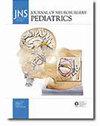Machine learning for enhanced prognostication: predicting 30-day outcomes following posterior fossa decompression surgery for Chiari malformation type I in a pediatric cohort.
IF 2.1
3区 医学
Q3 CLINICAL NEUROLOGY
引用次数: 0
Abstract
OBJECTIVE Chiari malformation type I (CM-I) is a congenital disorder occurring in 0.1% of the population. In symptomatic cases, surgery with posterior fossa decompression (PFD) is the treatment of choice. Surgery is, however, associated with peri- and postoperative complications that may require readmission or renewed surgical intervention. Given the associated financial costs and the impact on patients' well-being, there is a need for predictive tools that can assess the likelihood of such adverse events. The aim of this study was therefore to leverage machine learning algorithms to develop a predictive model for 30-day readmissions and reoperations after PFD in pediatric patients with CM-I. METHODS This was a retrospective study based on data from the National Surgical Quality Improvement Program-Pediatric database. Eligible patients were those undergoing PFD (Current Procedural Terminology code 61343) for CM-I between 2012 and 2021. Patients undergoing surgery for tumors or vascular lesions were excluded. Unplanned 30-day readmission and unplanned 30-day reoperation were the main study outcomes. Additional outcome data considered included the length of hospital stay, 30-day complications, discharge disposition, and 30-day mortality. Training and testing samples were randomly generated (80:20) to study the 30-day readmission and reoperation using logistic regression, decision tree, random forest (RF), K-nearest neighbors, and Gaussian naive Bayes algorithms. RESULTS A total of 7106 pediatric patients undergoing PFD were included. The median age was 9.2 years (IQR 4.7, 14.2 years). Most of the patients were female (56%). The 30-day readmission and reoperation rates were 7.5% and 3.4%, respectively. Headaches (32%) and wound-related complications (30%) were the most common reasons for 30-day readmission, while wound revisions and evacuation of fluid or blood (62%), followed by CSF diversion-related procedures (28%), were the most common reasons for 30-day reoperation. RF classifiers had the highest predictive accuracy for both 30-day readmissions (area under the curve [AUC] 0.960) and reoperations (AUC 0.990) compared with the other models. On feature importance analysis, sex, developmental delay, ethnicity, respiratory disease, premature birth, hydrocephalus, and congenital/genetic anomaly were some of the variables contributing the most to both RF models. CONCLUSIONS Using a large-scale nationwide dataset, machine learning models for the prediction of both 30-day readmissions and reoperations were developed and achieved high accuracy. This highlights the utility of machine learning in risk stratification and surgical decision-making for pediatric CM-I.增强预后的机器学习:预测小儿队列中I型Chiari畸形后窝减压手术后30天的预后。
目的I型硫脲畸形(CM-I)是一种先天性疾病,发病率占总人口的0.1%。对于有症状的病例,后窝减压术(PFD)是首选的治疗方法。然而,手术与围手术期和术后并发症有关,可能需要再次入院或重新进行手术治疗。鉴于相关的经济成本和对患者福祉的影响,我们需要能评估此类不良事件发生可能性的预测工具。因此,本研究旨在利用机器学习算法开发一种预测模型,用于预测儿科 CM-I 患者接受 PFD 后 30 天再入院和再次手术的情况。符合条件的患者是在 2012 年至 2021 年期间接受 PFD(当前手术术语代码 61343)治疗的 CM-I 患者。因肿瘤或血管病变接受手术的患者除外。研究的主要结果是非计划 30 天再入院和非计划 30 天再手术。考虑的其他结果数据包括住院时间、30 天并发症、出院处置和 30 天死亡率。使用逻辑回归、决策树、随机森林(RF)、K-近邻和高斯天真贝叶斯算法随机生成(80:20)训练样本和测试样本,以研究30天再入院和再手术情况。中位年龄为 9.2 岁(IQR 为 4.7-14.2 岁)。大多数患者为女性(56%)。30天再入院率和再手术率分别为7.5%和3.4%。头痛(32%)和伤口相关并发症(30%)是 30 天再入院的最常见原因,而伤口修补和液体或血液排空(62%)以及 CSF 分流相关手术(28%)是 30 天再次手术的最常见原因。与其他模型相比,射频分类器对 30 天再入院(曲线下面积 [AUC] 0.960)和再手术(AUC 0.990)的预测准确率最高。在特征重要性分析中,性别、发育迟缓、种族、呼吸系统疾病、早产、脑积水和先天/遗传异常是对两个 RF 模型贡献最大的变量。这凸显了机器学习在儿科 CM-I 风险分层和手术决策中的实用性。
本文章由计算机程序翻译,如有差异,请以英文原文为准。
求助全文
约1分钟内获得全文
求助全文
来源期刊

Journal of neurosurgery. Pediatrics
医学-临床神经学
CiteScore
3.40
自引率
10.50%
发文量
307
审稿时长
2 months
期刊介绍:
Information not localiced
 求助内容:
求助内容: 应助结果提醒方式:
应助结果提醒方式:


